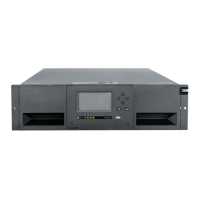Library functions
The library provides many specic functions, such as random or sequential operating mode, encryption,
library sharing, path failover, and alerts and logging.
Encryption
All supported tape drives in this library support encryption.
The encryption enabled drive contains the necessary hardware and rmware to encrypt and decrypt host
tape application data. Encryption policy and encryption keys are provided by the host application or host
server. A drive digital certicate is installed at manufacturing time. Each drive receives a unique serial
number and certicate. The T10 application might validate each drive instance by checking the drive's
digital certicate.
The library provides these options.
1. Encryption disabled
2. Application Managed Encryption (AME) is the default
3. Library Managed Encryption (LME). LME is a built-in feature that is enabled by using a purchased
license. The LME feature can be ordered from the factory, or you can order it as a eld upgrade. To
order a feature, contact your IBM Sales Representative or Business Partner. See Optional Features. For
conguration details, see “Conguring Library Managed Encryption” on page 88.
The default is Application Managed Encryption.
Note: All encryption settings must be congured or reveried in the drive after any library or drive reset. A
new drive might be added or an existing drive might be swapped with another drive.
Library sharing
The library can be congured into one or more logical libraries that can be shared by multiple
applications.
It is advantageous to be able to share a single physical library between heterogeneous or homogeneous
applications. However, some applications (and some servers) do not allow for sharing a library between
systems.
The library Management GUI provides two methods for logical library conguration.
1. A quick conguration for a simple one logical library conguration Manage Logical Library (Basic
Mode)
2. An advanced conguration action for a multiple logical library conguration Manage Logical Library
(Expert Mode)
Note: When any number of drives are loaded, a warning message appears when the Manage Logical
Library (Expert Mode) wizard is accessed.
The second method gives the ability to create congurations that enable the library to process commands
from multiple heterogeneous applications (such as an IBM System p application and a Windows
application) and multiple homogeneous applications (for example, the same application run by several
System p servers). See “Advanced library conguration” on page 71.
Control path failover, Data path failover, and load balancing
The path failover feature ensures the use of a redundant communication path when the primary path fails.
Command failures and time outs are costly. You want your library to run smoothly and efciently. Path
failover capabilities allow the IBM
®
device driver to resend a command to an alternate path. The alternate
path can include another host bus adapter (HBA), Storage Area Network (SAN), or library control path
drive. The device driver initiates error recovery and continues the operation on the alternate path without
interrupting the application.
IBM Condential
Chapter 1. Overview23

